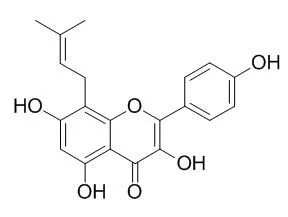| In vitro: |
| Life Sci. 2011 Feb 14;88(7-8):335-42. | | 8-Prenylkaempferol accelerates osteoblast maturation through bone morphogenetic protein-2/p38 pathway to activate Runx2 transcription.[Pubmed: 21163272] | In this study, we investigated the effect of 8-Prenylkaempferol (8-PK), a prenyl-flavonoid isolated from Sophora flavescens, on osteoblast differentiation and maturation.
METHODS AND RESULTS:
MC3T3-E1 cells were exposed to 8-Prenylkaempferol and the cytotoxicity was assayed. Osteoblast differentiation and maturation were evaluated by analyzing alkaline phosphatase (ALP) activity and cell mineralization, respectively. RT-PCR and Western blot were executed to determine the effects of 8-Prenylkaempferol on osteoblast differentiation-related gene expression and signaling pathway. 8-Prenylkaempferol significantly promoted ALP activity, up-regulated mRNA expressions of osteocalcin, osteopontin, and type I collagen, and induced bone nodules formation. Induction of differentiation by 8-Prenylkaempferol was associated with increased bone morphogenetic protein (BMP)-2 expression, and sequentially up-regulated the phosphorylations of Smad1/5/8 and p38, and increased the nuclear translocation of runt-related transcription factor 2 (Runx2). Addition of BMP-2 antagonist noggin blocked 8-Prenylkaempferol and recombinant mouse BMP-2-induced ALP activity, reconfirming that BMP-2 production is required in 8-Prenylkaempferol-mediated osteoblast differentiation. Noggin also abrogated 8-Prenylkaempferol evoked phosphorylations of Smad1/5/8 and p38, suggesting that BMP-2 signaling is required for p38 activation in 8-Prenylkaempferol-treated cells. Application of p38 inhibitor SB203580 repressed not only 8-Prenylkaempferol-mediated activation of ALP, but also the nuclear translocation of Runx2 and bone nodules formation.
CONCLUSIONS:
The present results suggested that BMP-2/p38/Runx2 pathways were involved in 8-Prenylkaempferol-induced differentiation/maturation of MC3T3-E1 osteoblasts and firstly demonstrated that 8-Prenylkaempferol might be a promising agent for inducing osteogenesis. | | Evid Based Complement Alternat Med. 2011;2011:920828. | | 8-Prenylkaempferol Suppresses Influenza A Virus-Induced RANTES Production in A549 Cells via Blocking PI3K-Mediated Transcriptional Activation of NF-κB and IRF3.[Pubmed: 19592477] | 8-Prenylkaempferol (8-PK) is a prenylflavonoid isolated from Sophora flavescens, a Chinese herb with antiviral and anti-inflammatory properties.8-Prenylkaempferol could significantly inhibit not only RANTES production but also NF-κB and IRF-3 nuclear translocation.
METHODS AND RESULTS:
We had proved that both NF-κB and IRF-3 participated in H1N1-induced RANTES production since NF-κB inhibitor pyrrolidinedithio carbamate (PDTC) and IRF-3 siRNA attenuated significantly RANTES accumulation. H1N1 inoculation also increased PI3K activity as well as Akt phosphorylation and such responsiveness were attenuated by 8-Prenylkaempferol. Furthermore, 8-Prenylkaempferol but not wortmannin, prevented effectively H1N1-evoked IκB degradation.
CONCLUSIONS:
In conclusion, 8-Prenylkaempferol might be an anti-inflammatory agent for suppressing influenza A virus-induced RANTES production acts by blocking PI3K-mediated transcriptional activation of NF-κB and IRF-3 and in part by interfering with IκB degradation which subsequently decreases NF-κB translocation. |
|






 Cell. 2018 Jan 11;172(1-2):249-261.e12. doi: 10.1016/j.cell.2017.12.019.IF=36.216(2019)
Cell. 2018 Jan 11;172(1-2):249-261.e12. doi: 10.1016/j.cell.2017.12.019.IF=36.216(2019) Cell Metab. 2020 Mar 3;31(3):534-548.e5. doi: 10.1016/j.cmet.2020.01.002.IF=22.415(2019)
Cell Metab. 2020 Mar 3;31(3):534-548.e5. doi: 10.1016/j.cmet.2020.01.002.IF=22.415(2019) Mol Cell. 2017 Nov 16;68(4):673-685.e6. doi: 10.1016/j.molcel.2017.10.022.IF=14.548(2019)
Mol Cell. 2017 Nov 16;68(4):673-685.e6. doi: 10.1016/j.molcel.2017.10.022.IF=14.548(2019)